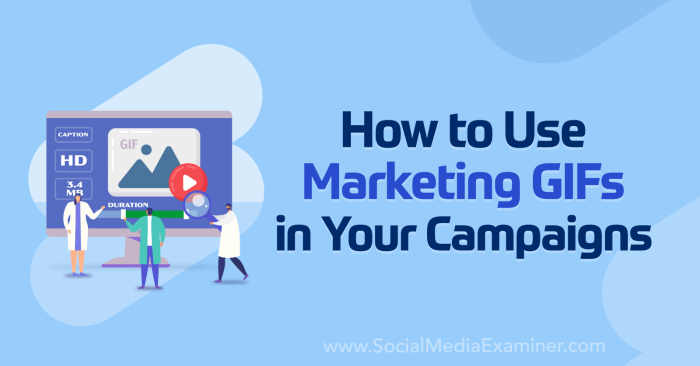Using GIFs in Marketing sets the stage for innovative and impactful strategies that captivate audiences and elevate brand recognition. From selecting the perfect GIF to analyzing performance metrics, this guide delves into the dynamic world of GIF marketing.
Importance of Using GIFs in Marketing
GIFs have become a powerful tool in modern marketing strategies, allowing brands to engage with their audience in a more dynamic and visually appealing way. By incorporating GIFs into marketing campaigns, companies can capture the attention of consumers and convey messages effectively.
Enhancing Brand Awareness
Utilizing GIFs in marketing can help brands stand out in a crowded digital landscape. For example, Wendy’s Twitter account gained attention for its witty GIF responses, showcasing the brand’s personality and humor. This unique use of GIFs helped Wendy’s increase brand awareness and engage with a younger audience.
Increasing Consumer Engagement
GIFs have the ability to evoke emotions and create memorable experiences for consumers. Brands like Nike have successfully used GIFs in their marketing campaigns to showcase product features, tell stories, and connect with their audience on a deeper level. This increased consumer engagement can lead to higher conversion rates and brand loyalty.
Driving Traffic and Conversions, Using GIFs in Marketing
Including GIFs in email marketing campaigns or social media posts can drive traffic to websites and increase click-through rates. For instance, Buzzfeed often incorporates GIFs in their listicles and articles, making the content more engaging and shareable. This strategy has proven to boost website traffic and conversions for Buzzfeed.
Best Practices for Incorporating GIFs in Marketing
When using GIFs in marketing, it is crucial to follow best practices to ensure they enhance your overall strategy and engage your audience effectively.
Selecting the Right GIFs
- Choose GIFs that align with your brand’s tone and message.
- Ensure the GIFs are relevant to the content they are associated with.
- Avoid using overly distracting or inappropriate GIFs that could detract from your marketing message.
Integrating GIFs into Various Marketing Channels
- On Social Media: Use GIFs to grab attention in feeds, convey emotions, and showcase products or services.
- In Emails: Include GIFs to make your emails more visually appealing and increase click-through rates.
- On Websites: Use GIFs to demonstrate product features, add visual interest to landing pages, and create interactive elements.
Creating Original and Relevant GIF Content
- Develop unique GIFs that set your brand apart and resonate with your target audience.
- Ensure the GIF content is contextually relevant to the marketing message you want to convey.
- Consider creating custom GIFs that reflect your brand’s personality and values.
Tools and Resources for Creating GIFs

Creating engaging GIFs for marketing purposes can be made easier with the help of various tools and software available in the market. These tools offer different features and functionalities to help you create eye-catching GIFs that will capture the attention of your target audience.
Popular Tools for Creating GIFs
- Giphy: Giphy is a popular platform that allows users to create GIFs from images, videos, and even YouTube links. It offers a wide range of editing tools and effects to customize your GIFs.
- Adobe Photoshop: Photoshop is a versatile tool that can be used to create high-quality GIFs by editing images and videos frame by frame. It provides advanced editing features for precise customization.
- Canva: Canva is a user-friendly graphic design platform that offers a simple drag-and-drop interface to create GIFs. It provides a library of templates and design elements to help you get started quickly.
Comparison of GIF Creation Platforms
| Tool | Features | Cost |
|---|---|---|
| Giphy | Wide range of editing tools and effects | Free |
| Adobe Photoshop | Advanced editing features for precise customization | Subscription-based |
| Canva | User-friendly interface with templates and design elements | Free with paid options |
Tips for Optimizing GIFs for Marketing
- Keep the file size small: Optimize your GIFs by reducing the number of frames and colors to ensure faster loading times on websites and social media platforms.
- Focus on quality: Maintain a balance between file size and image quality to ensure that your GIFs look crisp and clear on all devices.
- Use relevant content: Create GIFs that are relevant to your brand and message to effectively communicate with your target audience.
Analyzing the Performance of GIFs in Marketing Campaigns

When it comes to assessing the impact of GIFs in marketing campaigns, tracking and measuring their effectiveness is key to understanding their contribution to overall success.
Tracking and Measuring Effectiveness
To track and measure the performance of GIFs in marketing campaigns, businesses can utilize various analytics tools specifically designed for this purpose. These tools can provide insights into metrics such as:
- Engagement Rate: Measure how users interact with GIFs, including likes, shares, and comments.
- Click-Through Rate (CTR): Monitor the number of clicks generated by GIFs leading to a website or landing page.
- Conversion Rate: Evaluate the percentage of users who took a desired action after viewing the GIF.
- View Count: Track the total number of views the GIF receives across different platforms.
A/B Testing for Optimization
A/B testing involves creating multiple versions of a GIF with slight variations and comparing their performance to determine the most effective one. By testing factors like color, text, or duration, businesses can optimize their GIFs for better marketing results.
